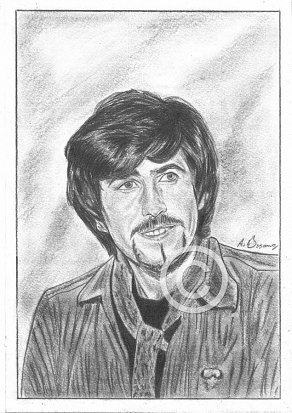Graham Nash
Pencil Portrait by Antonio Bosano.

Shopping Basket
The quality of the prints are at a much higher level compared to the image shown on the left.
Order
A3 Pencil Print-Price £45.00-Purchase
A4 Pencil Print-Price £30.00-Purchase
*Limited edition run of 250 prints only*
All Pencil Prints are printed on the finest Bockingford Somerset Velvet 255 gsm paper.
P&P is not included in the above prices.

Recommended reading
Wild tales - A Rock & Roll Life By Graham Nash
Surfing
CSNY - Official Website
http://www.csny.com/”:http://www.csny.com/”:http://www.csny.com/


Comments
In his 2013 autobiography, “Wild Tales,” Graham Nash tells more than a few about the supergroup CSN & Y constantly at each other’s throats in drug-fueled rages, while the world grooved to their harmonies.
CS&N still tour the world, and Neil Young’s career as a living legend is thriving. The wonder is not that they are all still making music — it’s that they are all still alive. Of course, David Crosby had to be reconstituted with a new liver, but this band for years seemed destined for a drug fatality or two.
Maybe it’s all down to the luck of the draw, but more detailed research suggests otherwise.
A 2007 study published in the Journal of Epidemiology and Community Health was the first attempt to quantify the popular assumption that rock stars tend to live fast and die young. These public health professionals investigate patterns and causes of disease and injury in humans, and seek to reduce the risk and occurrence of negative health outcomes through research, community education, and health policy. According to the journal, rock and pop stars are nearly twice as likely to suffer a premature death as the rest of us. The causes include violence and suicide, and about a quarter of the premature deaths are related to substance abuse. This study even flagged up an interesting distinction between North American and European rock stars, suggesting that the former remain at high risk throughout their careers, whilst the latter tend to return towards the survival patterns of the general population, provided they live through their first twenty five years of fame.
http://www.ncbi.nlm.nih.gov/pmc/articles/PMC2652970/
Author Brian Southall published the first full scale biography of The Hollies in 2015, a band that had
two remarkable careers. Their amazing run of three-part harmony hits every year came to an end when Graham Nash left for the US taking his new songs Marrakesh Express and Teach Your Children with him to form Crosby, Stills & Nash. But a second run of success was kick-started with a wave of classic singles led by He Ain’t Heavy, He’s My Brother and The Air that I Breathe dominated charts and the airwaves in the 1970s.
Southall himself, was was amazed to discover that a book had never been written about the group.
“They were huge in the 60s and came out of Manchester. Allan Clarke and Graham Nash met at school when they were about six. They sang in the school choir. They got guitars at 14. Then came the great moment in their life which was seeing and hearing the Everly Brothers, who had great harmonies which, of course, was what Allan and Graham had. They were their heroes. They went on to play in various Manchester bands, primarily the Four Tones – “there were actually five people in it, so I’ve never quite worked that one out,” says Brian.
When they split up Allan and Graham played around Manchester – “there was a very cliquey music scene going on in Manchester in the 60s. Manchester had more clubs than Liverpool, The Twisted Wheel, the Oasis. That’s where they all met and teamed up.”
In 1962 they were playing the Oasis Club in Manchester and the MC asked Allan Clarke what the band was called. They didn’t have a name, so someone shouted out ‘The Hollies,’ but no-one was quite sure whether it was because it was Christmas or in recognition of Buddy Holly, who was a hero of theirs. Bizarrely, that band didn’t include the only two members who are in The Hollies today – Tony Hicks and Bobby Elliott, who came from Burnley.”
In early 1963 the band were playing in Liverpool at The Cavern and Ron Richards, one of the great EMI producers, saw The Hollies and wanted to sign them. EMI’s top man George Martin was busy producing The Beatles and Gerry and the Pacemakers, and charged Ron with looking after them. He took them to London, with Tony Hicks in the line-up and Don Rathbone on drums. Southall reveals in his book that “Don’s dad was an undertaker and he had access to his van, which was very important because if you didn’t have transport you had to take your instruments on the bus.”
Eventually Don would be replaced by Bobby Elliott, who was playing with Shane Fenton (later to become Alvin Stardust). The first incarnation of the band was now in place – Graham Nash and Allan Clarke on vocals, Eric Haydock on bass, Tony Hicks on guitar and Bobby Elliott on drums. They lasted together until 1966 and had a number one hit with ‘I’m Alive.’
Haydock’s departure from the band is one of the murkier aspects to the history, but when Bernie Calvert – who was a friend of Hicks and Elliott – stepped up, this line-up would hold tight through a string of hits; “Carrie Ann, Carousel, Jennifer Eccles, Stop, Stop, Stop” – an enormous number of hits.
Graham Nash, seduced by the lure of hippieland, left the band in late ’68. His time as a ‘northern bloke’ was over and ‘for every pint of beer they had, I had another joint.’
And the rest, as they say, is history.